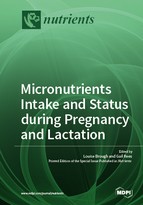Micronutrients Intake and Status during Pregnancy and Lactation
A special issue of Nutrients (ISSN 2072-6643).
Deadline for manuscript submissions: closed (30 November 2018) | Viewed by 51067
Special Issue Editors
Interests: iodine; thyroid; micronutrients; pregnancy; breastfeeding; infancy
Special Issues, Collections and Topics in MDPI journals
Interests: dietary interventions to improve nutrition in women during pregnancy and in young children; management of obesity during pregnancy and childhood; micronutrient status in women and children
Special Issues, Collections and Topics in MDPI journals
Special Issue Information
Dear Colleagues,
Optimal nutrition is important during pregnancy and lactation for the health of both the mother and infant. Chronic deficiencies of both macronutrients and micronutrients are well established in developing countries. Although in developed countries overconsumption of macronutrients is a major issue, micronutrient deficiencies which occur concomitantly are no less of a concern. Furthermore in developed countries there is also the risk of excessive micronutrient intake from dietary supplements.
Micronutrients have a role in fetal and neonatal health and also health in later life. Micronutrient deficiency or toxicity during pregnancy or early life can permanently affect developing tissues, resulting in adverse growth and development of the infant which is associated with chronic diseases in adulthood. An aberrant micronutrient intake during pregnancy or lactation can also have detrimental effect on the mother both in the neonatal period and in later life.
This Special Issue of Nutrients entitled “Micronutrient Intake and Status during Pregnancy and Lactation” welcomes the submission of manuscripts describing either original research, systematic reviews or meta-analyses.
Manuscripts will be considered concerning the effects of both micronutreint deficiency and toxicity in developing or developed countries.
Dr. Louise Brough
Dr. Gail Rees
Guest Editors
Manuscript Submission Information
Manuscripts should be submitted online at www.mdpi.com by registering and logging in to this website. Once you are registered, click here to go to the submission form. Manuscripts can be submitted until the deadline. All submissions that pass pre-check are peer-reviewed. Accepted papers will be published continuously in the journal (as soon as accepted) and will be listed together on the special issue website. Research articles, review articles as well as short communications are invited. For planned papers, a title and short abstract (about 100 words) can be sent to the Editorial Office for announcement on this website.
Submitted manuscripts should not have been published previously, nor be under consideration for publication elsewhere (except conference proceedings papers). All manuscripts are thoroughly refereed through a single-blind peer-review process. A guide for authors and other relevant information for submission of manuscripts is available on the Instructions for Authors page. Nutrients is an international peer-reviewed open access semimonthly journal published by MDPI.
Please visit the Instructions for Authors page before submitting a manuscript. The Article Processing Charge (APC) for publication in this open access journal is 2900 CHF (Swiss Francs). Submitted papers should be well formatted and use good English. Authors may use MDPI's English editing service prior to publication or during author revisions.
Keywords
- Micronutrient deficiency
- Micronutrient toxicity
- pregnancy
- lactation
- breastfeeding








